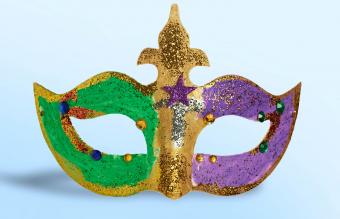
Perhaps most famously referenced in Romeo and Juliet, Elizabethan masquerade masks took their cue in appearance from masks used for drama and masquerade balls in Italy, and especially Venice.
Elizabethan Masquerade Masks in Shakespeare
Many productions of Shakespeare's Romeo and Juliet choose to forgo the costume aspect of the ball the Capulets threw for a variety of reasons. But the text is plain - the only way Romeo, a hated Montague, can join the party is because it is a masked ball. He cleverly puts on a disguise, goes inside, sees Juliet and one of the most famous romances in history is underway.
Everyone in the Elizabethan audience would have recognized this party. Masked balls had been popular in England since the court of Henry VIII. Because the balls themselves have such dramatic heft and promise, it is no wonder that they were incorporated into plays, whether for tragedy, as in Romeo and Juliet or comedy, as in Much Ado About Nothing. The disguises allow the characters to play tricks or cause trouble, much the same as they could actual attendees of masked balls.
History of British Masks
Although Elizabethan masquerade masks took much of their style and design from the masks of the Italian Renaissance, there was a rich history of masks being used in drama in Britain. Masks were used by the early medieval "mummers," performers who enacted famous stories and legends all in mime. So far as records show, the original masks worn by mummers were simple, worn merely to disguise the performer who was one of the local community. Later, they grew more elaborate and representative of characters, much like masks worn in Commedia del'Arte.
Fantasy Costumes
Elizabethan masks tended to be highly elaborate. Costumes worn to the balls were of a truly fantastic nature, much more so than many of the costumes used in theatre. This made sense, as the theatres, then as now, were relatively poor and had to do the best they could with suggestion, whereas the attendees of masked balls were wealthy and could indulge their every whim in commissioning amazing costumes. Fairies and mythical creatures were favorite subjects, as were Greek gods or legendary characters.
The Role of Women
As is well known, women were not allowed to perform on stage. However, women were allowed and even encouraged to perform in masques. This was partly because they were all upper class women and so it wasn't considered immoral - a peculiar distinction, considering that the masques allowed men and women to behave much more indecently than they were usually allowed.
Although masked balls are generally assumed to be only about dancing, an Elizabethan masque combined dancing with a scenario. The court could act out scenes from stories and individuals could sing. As such, masques were usually given a theme and everyone dressed accordingly. For the women, this could allow for some real diversion and liberation. In their daily roles, they were expected to act with strict decorum - misbehavior could lead to being ejected from court, which was a serious disgrace. But in a disguise and playing a part, they could let loose for a few hours and show off and flirt. This was no small matter. A flirtation while wearing an Elizabethan mask could potentially lead to courtship and marriage, which was a very serious business among court ladies.
Modern Masks
Whether for Mardi Gras or a reproduction ball in full Elizabethan costume, a costume is not complete without a traditional mask. Because these masks are so specific and can be complex, you should not attempt to make one yourself unless you are an accomplished mask maker. If you want to know more details, read our article on Elizabethan Costume. You should also reasearch nformation and perhaps contact someone to commission a custom mask at mask Makers Web. Be prepared to dazzle!







